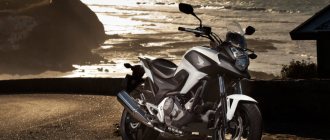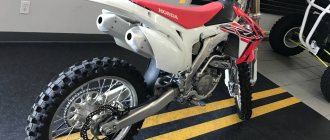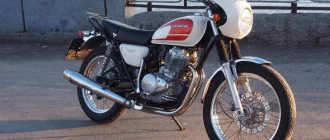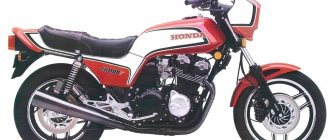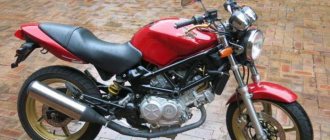| Honda CTX700 (2014-2018) | Honda CTX700N (2014-2018) |
Model series Honda CTX700
appeared on the market on July 11, 2013, introducing the
Honda CTX700N
- a road motorcycle with the features and ergonomics of a cruiser.
On August 6 of the same year, the line was replenished with a touring version of the Honda CTX700
, featuring plastic wind protection. The new model series CTX stood for Comfort, Technology, eXperience.
The base and configuration of the Honda NC700 was taken as the basis for the Honda CTX700. Thus, for the regular versions of the CTX700, models were offered with combined ABS (C-ABS), as well as with an automatic transmission (DCT - dual clutch transmission). In general, the CTX700 series is budget and has nothing in common, except the name of the series, with the Honda CTX1300 model.
The Honda CTX700 engine is an in-line 2-cylinder liquid-cooled unit with a displacement of 669 cm³ and produces 48 hp. power and 60 Nm of torque. The engine is a redesigned version of the Honda Jazz car engine with a 270° crankshaft.
Other features of the Honda CTX700 include a steel frame, simple suspension in the form of a conventional telescopic fork and a progressive rear monoshock absorber, a 12-liter fuel tank, a 6-speed gearbox and a curb weight of 219 kg.
The CTX700 series models were available primarily in the Japanese, North American and Australian markets. At the same time, the model is practically not represented on the European market.
The Honda CTX700 model was produced until 2021 inclusive, after which it was discontinued. As of late 2021, the 2021 model is available in the US market.
The main competitors of the Honda CTX700 in the class:
- Kawasaki Vulcan S
Brief history of the model
- 2013 (2014) - start of production and sales. This year's models are the same as 2014 models.
Model
: Honda CTX700 + ABS, CTX700D (DCT - dual clutch transmission);
Honda CTX700N + ABS, CTX700ND (DCT) (Japan, North America, Australia, Europe). Factory designation
: CTX700E, CTX700AE, CTX700DE; CTX700NE, CTX700NAE, CTX700NDE.
- 2015 - no significant changes.
Model
: Honda CTX700 + ABS, CTX700D (DCT);
Honda CTX700N + ABS, CTX700ND (DCT) (Japan, North America, Australia, Europe). Factory designation
: CTX700F, CTX700AF, CTX700DF; CTX700NF, CTX700NAF, CTX700NDF.
- 2016 - no significant changes.
Model
: Honda CTX700 + ABS, CTX700D (DCT);
Honda CTX700N + ABS, CTX700ND (DCT) (Japan, North America, Australia, Europe). Factory designation
: CTX700G, CTX700AG, CTX700DG; CTX700NG, CTX700NAG, CTX700NDG.
- 2017 - this year only the touring version with automatic transmission and the regular version with ABS are available.
Model
: Honda CTX700 ABS, Honda CTX700D (DCT) (Japan, North America, Australia, Europe).
Factory designation
: CTX700AH, CTX700DH.
- 2018 is the last year of production.
Model
: Honda CTX700D (DCT);
Honda CTX700N (DCT) (North America). Factory designation
: CTX700DJ; CTX700NDJ.
Chassis and brakes
The frame of this bike is made of steel. The exterior looks stylish, including thanks to the elegant shape of the steering wheel and alloy wheels. The CTX 700 looks at least modern, and some would even say that this motorcycle has a futuristic look.
At the rear, the suspension is a monoshock, and at the front there is a 41 mm telescopic fork. A completely justified solution for such a machine. The CTX 700 brakes at the rear with a 240 mm disc and two-piston caliper, and at the front with combination brakes including a 320 mm disc and two-piston caliper. Possibly ABS.
Specifications
Technical characteristics of Honda CTX700:
| Model | Honda CTX700 |
| Motorcycle type | tourist (Honda CTX700) cruiser (Honda CTX700N) |
| Year of issue | 2013-2018 |
| Frame | steel diamond-shaped |
| engine's type | 2-cylinder, 4-stroke, in-line (55° tilt) |
| Working volume | 669 cm³ |
| Bore/Stroke | 73.0 x 80.0 mm mm |
| Compression ratio | 10.7:1 |
| Cooling | liquid |
| Number of valves per cylinder | SOHC, 4 valves per cylinder |
| Fuel supply system | injector, PGM-Fi, 36 mm |
| Ignition type | transistor |
| Maximum power | 48.0 hp (35.0 kW) at 6250 rpm |
| Maximum torque | 60.0 Nm (6.1 kg*m) at 4750 rpm |
| Clutch | Multi-disc in oil bath, cable drive 2 multi-disc packs in oil bath (version with DCT automatic transmission) |
| Transmission | 6-speed - CTX700/N DCT - automatic robotic with two clutches - CTX700D/ND |
| type of drive | chain |
| Front tire size | 120/70ZR17M/C (58W) |
| Rear tire size | 160/60ZR17M/C (69W) |
| Front brakes | 1 disc, 320 mm, 2-piston caliper (C-ABS - 3-piston) |
| Rear brakes | 1 disc, 240 mm, 1-piston caliper (C-ABS) |
| Front suspension | 41 mm telescopic fork (without adjustments), travel - 107 mm |
| Rear suspension | pendulum Pro-Link with monoshock absorber (preload adjustment), stroke - 109 mm |
| Motorcycle length | 2255 mm |
| Motorcycle width | 855 mm – CTX700/CTX700N 840 mm – CTX700D / CTX700ND (DCT) |
| Motorcycle height | 1155 mm – CTX700N 1165 mm – CTX700 |
| Wheelbase | 1530 mm |
| Seat height | 720 mm |
| Minimum ground clearance (clearance) | 130 mm |
| Acceleration 0-100 km/h (0-60 mph) | 6.1 sec[1] |
| Maximum speed | 168 km/h[2] |
| Gas tank capacity | 12.4 l – CTX700/N (Europe) 12.0 l – CTX700/N (Japan, North America) |
| Motorcycle weight (curb) | 219 kg – CTX700N (ABS) 227 kg – CTX700ND (DCT) 226 kg – CTX700 (ABS) 234 kg – CTX700D (DCT) |
Honda CTX700A – TEST
2014 onwards, 670 cm3, 48 l. s., 244 kg, 440,000 rub.
text: Alexander Barkalov photo: Nikita Kolobanov
in the photo: Alexander Barkalov
“Over the past few years, Honda has been boldly experimenting with crossing motorcycles from different segments, creating new, never-before-seen subclasses of equipment. The CTX family became one of the latest “acts” of genetic engineering of the Japanese concern, which tried to combine the advantages of three seemingly most distant types of motorcycles: naked, cruisers and tourers.
Common roots As has happened more than once in Honda's history, the debut in 2012 of the new NC700 family of road motorcycles led to a small but significant revolution in the industry. Initially, the Japanese released simple and unpretentious naked bikes and crossovers onto city streets, characterized by outstanding efficiency and ease of control. It turned out that the universal base of the NC700 suits so many different devices surprisingly well, so Honda decided to further expand the model range by adding touring motorcycles. In the winter of 2013, at the international motor show in Chicago, two new models built on a popular base were presented: the touring CTX700 and its naked version, the CTX700N. CTX (Comfort Technology Experience) devices were conceived as full-fledged universal motorcycles for every day and for long trips, made in the format of cruisers. The main design idea was the Horizontal Line Styling concept, with a characteristic low and elongated silhouette - this concept was also implemented in the Gold Wing F6B Bagger. It is certainly impossible to say that the design of the Honda CTX700 will appeal to everyone. In addition, we can say with a high degree of confidence that adherents of “real iron” motorcycles will generally be skeptical about the curved lines of a “plastic” cruiser. On the other hand, the CTX700 is positioned as an entry-level model aimed at young motorcyclists and the fair sex. And this audience has always been distinguished by multipolar views in matters of perception of design and aesthetics.
And if the question of the motorcycle’s extraordinary appearance remains open and may well become a reason for heated discussions, then the ergonomics of the driver’s seat in most cases causes an unambiguous reaction. When you sit behind the wheel of the CTX700, you find yourself not just on the seat, but as if “immersed” inside the motorcycle, becoming part of it. Such unusual sensations are due to the original posture formed by the low seat, wide and high handlebars and the footpegs placed far forward. Out of habit, you instinctively try to find a place to rest your feet in a familiar place, but over time you stop paying attention to this ergonomic feature. Otherwise, the pilot's position behind the wheel of the CTX700 can be called quite comfortable - especially for people of small and medium height. The “cruiser” dashboard is similar to those installed on the NC700S, the NC700X crossover and the Integra 700 maxi-scooter. Although the information content is quite high, the panel cannot boast of good readability of the readings - mainly due to the tape tachometer, made in the format of a running “snake”. Despite the same “base” with the naked NC700S, which implies the unification of components and assemblies, the CTX700 still has one significant difference, which is the fuel tank, located in a place familiar to most motorcyclists. Where the NC has a luggage capacity for storing a full-fledged integral helmet, the CTX has a hinged lid that hides a filler neck and a small compartment that can accommodate documents, a mobile phone and a bunch of keys.
cut-off is equipped with a 2-cylinder in-line engine with a displacement of 670 cm3, which has already proven itself well on devices of the NC family and the Integra scooter. Japanese designers decided not to tempt fate in trying to improve what was good, leaving the power unit without the slightest changes. The logic of the specialists at Honda headquarters is quite clear, because the smooth characteristics of the parallel “twin” are equally well suited for both a city motorcycle and a device for country trips and long trips. Modest by modern standards 48 liters. With. available at around 6250 rpm, and the engine produces peak torque values after 4500 rpm. Much more interesting than the maximum power indicators is the graph of its distribution: the horsepower output of the Japanese “two” occurs almost linearly and predictably. In turn, the torque graph also resembles a straight line, as if drawn with a ruler. Already from idle, the engine demonstrates confident traction, which does not weaken until the limiter is activated (at approximately 6325 rpm). As on the NC700S, the moment of activation of the limiter is not easy to track, and the “cutoff” itself is quite rigid. And everything would be fine, but you have to constantly turn the almost 700 cc engine, which is why encounters with the electronic “noose” occur more often than desired.
When talking about the CTX700 engine, Honda isn't afraid to use phrases like "outstanding fuel efficiency," which turns out to be true and not just another marketing gimmick. In city use, the engine demonstrates record low gasoline consumption - about 3.5 liters of AI-95 per 100 km! With such meager fuel consumption, the autonomy of the motorcycle rises to the level of serious touring machines, and this is about 350 km on one gas station. At the same time, on country trips in the “forgot to turn off the iron” driving mode, the 2-cylinder engine demonstrates a slightly larger, but still impressively modest appetite. On a fully filled tank with a volume of 12.4 liters at a speed of 140–150 km/h, you can easily travel 250 km, after which the indicator begins to flash, notifying you of the need to visit the gas station. Of course, in an effort to achieve outstanding efficiency results, Honda specialists had to make certain concessions, sacrificing maximum power and the breadth of the operating range of the power plant. However, there is no need to complain about the total weakness of the device. In the city, the CTX700 feels quite confident and is able to move quite dynamically in space. On country roads there are also no problems with overtaking or rapid acceleration. The CTX can only boast a maximum speed: it takes quite a long time for the motorcycle to accelerate to 170 km/h, and if there is a passenger, even this modest value becomes inaccessible to it.
The standard budget price tag of the Honda CTX700 suggests that most of its components do not spoil the owner of the motorcycle with outstanding characteristics and advanced technologies, but at the same time copes well with their functions. Thus, the positioning of the device is immediately revealed by a single brake disc on the front wheel and a thin fork, devoid of adjustments. By and large, despite its simplicity, serious claims cannot be made against the motorcycle braking system. The 320 mm disc and Nissin 2-piston caliper, supported by a 240 mm rear disc with a 1-piston caliper, are capable of predictably stopping not the lightest motorcycle from any speed. As a safety net, the Honda unit is equipped with combined ABS. The brakes and suspension of the motorcycle match: a non-adjustable fork with “bicycle” stays with a diameter of 41 mm, plus a pendulum rear suspension with a simple monoshock absorber. At the same time, the chassis potential is sufficient for everyday movement around the city and comfortable “long-distance driving” on roads of varying quality. It is also worth noting that the CTX700 has good handling. The main merit of the device's agility, it seems to me, is the low center of gravity: the engine is placed quite low in the steel tubular frame, and the cylinder block is inclined at a large angle forward. In turn, all the most significant parts in the literal sense of the word are assembled as close as possible to the center of mass of the device, which gives a balanced load on both wheels. The motorcycle is able to easily and quickly move from one turn to another and is endowed with enviable maneuverability, making it easier to move around the city even during the busiest rush hour. But there’s no need to revel in high-speed cornering on the CTX700: even at the most “civil” angles, the vehicle’s footrests begin to cling to the asphalt surface too early. But the owner always has the opportunity to take a turn, effectively sparkling the running boards under the admiring glances of passers-by.
Trending? Like the NC700S model, which essentially gave birth to a whole line of new motorcycles from Honda, the CTX700 turned out to be quite an interesting device. An intricate cross between a city bike, a cruiser and a tourer all rolled into one, the CTX has distinct features, be it its distinctive stance, bold design, frame construction or fuel-efficient engine. The Honda CTX700 is a motorcycle that attracts the buyer first of all with its unusual appearance, and only then captivates with its ease of operation, good performance and low cost. By adhering to the chosen strategy, the Honda concern in the very near future can make its simple mid-sized models extremely popular, thereby winning a huge new audience from among neophytes and people who, by and large, are far from motorcycling. And stylish cars like the Honda CTX700A may well be on the list of essential products for today's young people - along with an iPhone, a DSLR camera or a Diet Coke. /
Reviews
Reviews about Honda CTX700:
Expand Collapse
I myself have been riding this one since May 1st. Without fairing, white. I took it for 420. I have already passed TO1000. It drives well, I constantly restrain myself so as not to go beyond 80 km/h. From 2000 rpm it pulls perfectly. The seating position is very comfortable, feet first, but you can’t stand up on speed bumps. It is very easy to control and takes turns well. But I’ll make a reservation right away: this bike is not for racing, but for a measured ride. By the way, I don’t see any problems in the row spacing either: 85 cm in width along the handles is normal for me. I also drove with the second number - no problems either.
I took one for myself on the automatic with fairings! I can’t say anything bad yet! Handling is excellent! For me personally, the fit is comfortable, comfortable! But it’s still not possible to install panniers, a wind deflector, a trunk and arches (the sales guys say the model is new; nothing has been attached to it yet). I ordered everything I need, now I'm waiting! By next season I will be fully equipped!
For whom
Here's what's good about this car:
- comfortable fit;
- high-quality wind protection;
- good dynamic characteristics.
This model is suitable for connoisseurs of small motorcycles, suitable for leisurely riding both on city streets and on highways outside urban areas where the wind picks up. However, this bike is not the best option for traveling.
Joy at the gas station
Even if the suspension is fairly basic (you can only adjust the shock spring preload), they have a relatively firm setup and offer decent feedback and good comfort. The backrest feels under-damped, but the 41mm fork smooths out the bumps nicely.
Now the CTX 700 will go to Europe
One brake disc at the front lingers enough. The back, however, brakes less effectively and reacts rather dullly. Unlike the NC 700, the CTX does not have CBS. The CTX has a few downsides - the famous turn signal switch with horn (Honda insists it's better) or the dummy's small fuel tank storage space (in the NC 700 you can fit a built-in helmet there). Fortunately, you forgot about everything at the gas station: the combustion was 3.3 l/100 km.
Who's against it?
In our market, which is flooded with old “square” sportbikes, it is even more difficult to find a universal motorcycle. It seemed that the M1NSK Goose fits the concept of a universal bike well: 400 cc, lightweight, but with enough engine for the track. Not a bad option, but also economical. But it costs $3,000 new, and how it will fare with spare parts is a big question. And this is one cylinder, not two. Usually these motorcycles have strong vibrations, which become annoying on a long journey.
Aprilia Pegaso and BMW F650GS are two related motorcycles. And there is an even more recent F800GS. Moreover, BMW is popularly called a “goose”, or more precisely a “caterpillar”, which is where the name M1NSK comes from. Our marketers. But the former consume about 6 liters per “hundred”, which is not particularly economical. In addition, there are some nuances with the Rotax engine, such as the overrunning clutch, which periodically requires replacement. And again, this is one cylinder - there are more vibrations. The more recent twin-cylinder F800GS? A good option. But in the used market it is more expensive than the Honda NC700X.

